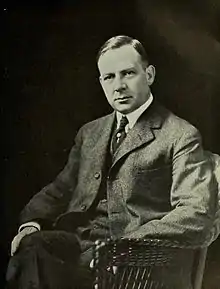Lotus Coffman
Lotus Delta Coffman was the fifth president of the University of Minnesota, serving from 1920 until his death in office on September 22, 1938.[1] Coffman Memorial Union, the main student center, is named in his memory.
Lotus Coffman | |
|---|---|
 Portrait of Lotus Coffman | |
| 5th President of the University of Minnesota | |
| In office 1920–1938 | |
| Personal details | |
| Born | January 7, 1875 Salem, Indiana |
| Died | September 23, 1938 (aged 63) Brooklyn, Iowa |
| Spouse | Mary Emma Farrell |
| Alma mater | Indiana State University |
Career overview
Lotus Delta Coffman, son of Mansford Coffman and Laura Davis, was born January 7, 1875, in Salem, Indiana. He married in Salem on December 28, 1899, to Mary Emma Farrell born September 12, 1877 Paoli, Indiana, daughter of William H.H.P. Farrell & his first wife Mary A. Wible. Coffman was a graduate of Salem High School in 1892 and a graduate of Indiana Normal School at Terre Haute, in 1896, where he played quarterback on the football team. He earned an AB degree from Indiana University, 1906; an AM degree there, 1910; a Ph.D. at Columbia, NY, 1911. He later received a LLD from Indiana University and from Carleton College in 1922; a LLD from Columbia University, 1929 & a LLD from the University of Michigan, 1931; a LHD from University of Denver, 1930 and a DS degree in education from George Washington University, 1930.
Coffman was principal of Salem, Indiana schools from 1900 to 1903; Superintendent of Salem schools 1903–1906; superintendent of Connersville School 1906–1908; director of training at Charleston, Illinois Normal School 1908–1912; dean of education at the University of Illinois 1912–1915; Dean of the College of Education at the University of Minnesota 1915–1920; and President of the University of Minnesota 1920–1938.
He was a visiting professor for the Carnegie Endowment for International Peace to New Zealand and Australia 1931; visiting lecturer at the University of the Philippines 1932; member of the National Board of Education to do research in Russia and visit Poland & Germany; was a consultant to the US Department of Interior on a Land Grant College Survey 1928–1930; and advisor to the Surgeon General on education of disabled soldiers during WWI.
He started at the University of Minnesota with a $12,000 annual salary. The university then had 8,200 students on campus. There was $6.5 million spent on maintenance of the campus annually. The School of Education enrolled 600 and had 50 faculty members. The Music School building was under construction in 1920. After 10 years as president, the university's property values had increased more than 100%; the budget increased 68%; enrollment increased 60% in undergraduate classes and over 100% in graduate studies; staff increased from 479 to 825 with 25% having the rank of professor—becoming the third largest university in the US. During Coffman's time the Memorial Stadium was built, Northrop Auditorium and the Walter Library were added; and the Mayo brothers (Wm J. & Charles H.) gave the university $2 million for endowment of the Mayo Foundation for Graduate Medical Study and Research.
Coffman's watch on the university included vigorous surveillance of alleged campus "radicalism," the number of Jews admitted to the university, and determined promotion of racial segregation in the university's dormitories. Black students mistakenly placed in university dormitories at admission were forced to leave, often after just one night's residence. Coffman rejected student protests. Despite a student-led substantial report comparing the university's segregated housing with integrated housing at other universities, Coffman insisted that "the races have never lived together nor have they ever sought to live together."[2] Coffman's administrators compiled lists of "radical leaders" and numerical counts of Jews and blacks who had been admitted to the university, practices that continued throughout Coffman's presidency. University housing was integrated in 1938 only when the historian Guy Stanton Ford succeeded Coffman as president after Coffman's death. Housing segregation was briefly reintroduced when Walter Coffey succeeded Ford as president in 1941, but protests forced Coffey to abandon the attempt.[3]
After a year's leave of absence due to a heart attack at his summer home in Battle Lake, Minnesota, in July 1937, he resumed his job in July 1938. Coffman died on September 23, 1938.[4]
Opening in 1940, Coffman Memorial Union on the University of Minnesota's Minneapolis campus is named in honor of President Coffman.
References
- American Council on Education 1939
- Pres. Coffman to John R. Pinkett Sr., Oct. 5, 1931, in University Archives, Office of the President, Administration, Box 20, folder 19, pg. 34.
- Sharyn Jackson, "New Exhibit Reveals U's Dark History of Segregation and Anti-Semitism," Minneapolis Star Tribune, Sept. 12, 2017. http://www.startribune.com/new-exhibit-reveals-u-s-dark-history-of-segregation-and-anti-semitism/443978873/
- "Lotus D. Coffman died Thursday, Sept. 23, 1938, age 63". Minneapolis Morning Tribune. p. 1.
- American Council on Education (1939). The Educational Record. American Council on Education.
External links
- "Lotus Coffman". University of Minnesota Office of the President.
- Works by or about Lotus Coffman at Internet Archive